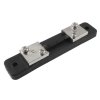Right there where you said "5W", that's inefficient. An entire ohm is out of the ballpark. A whole ohm might be used if the current is less than 100mA.
For me, on the LM3414 driver, efficiency is the difference between an inefficient 0.200 ohm inductor resistance vs. a 0.05 ohm inductor (all current to the LEDs goes through the inductor).
That's why we use drivers, they are A LOT more efficient than a resistor.
If I don't care about efficiency I'll use an on-board 0.01 ohm, 1% resistor.
To measure current with a resistor, this is the resistor I use:
View attachment 3929544










